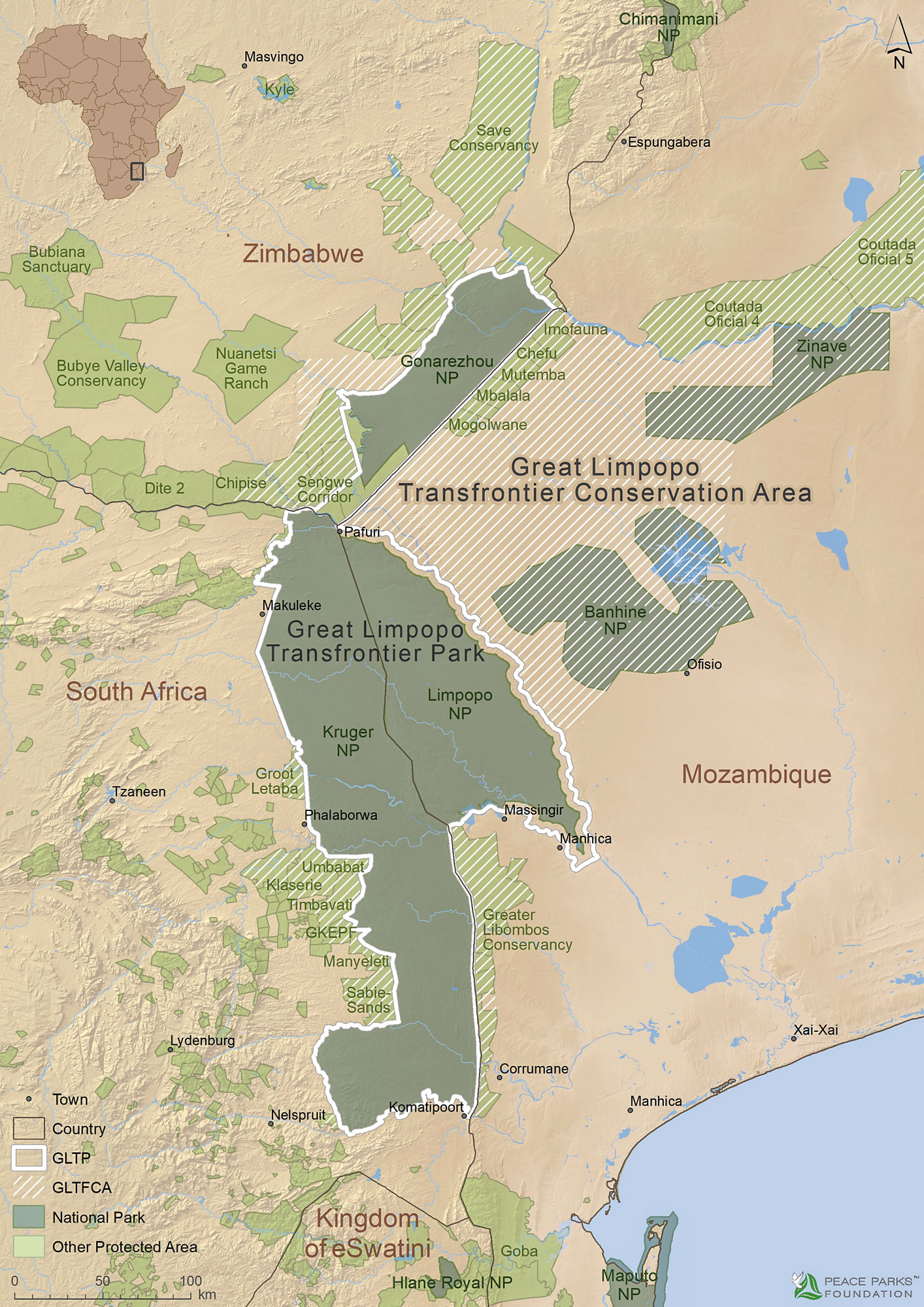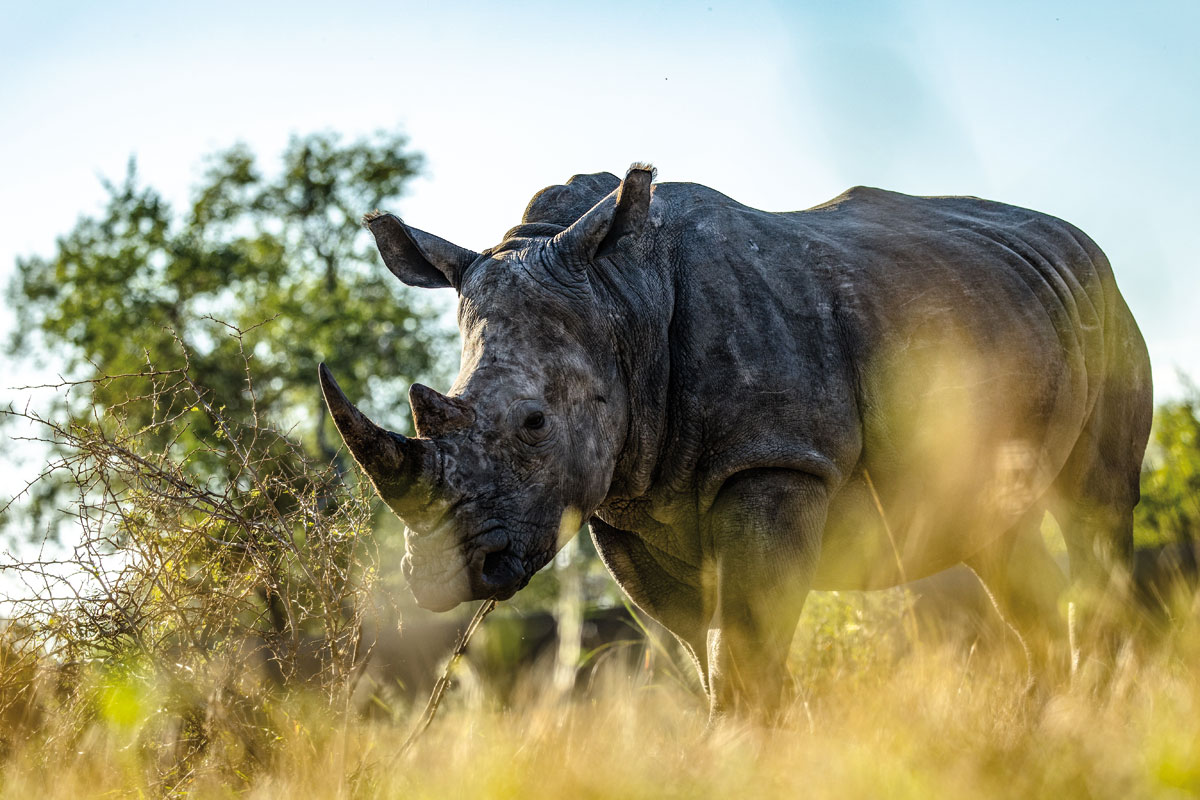Africa’s Cross-Border Conservation
First published in Sanctuary Asia,
Vol. 43
No. 10,
October 2023
By Freddie Ugo
I know of no political movement, no philosophy, and no ideology which does not agree with the Peace Parks concept as we see it going into fruition today. It is a concept that can be embraced by all. In a world beset by conflict and division, peace is one of the cornerstones of the future. Peace Parks are building blocks in this process, not only in our region, but potentially the entire world.
– Former President of South Africa, Nelson Mandela, 1997
A Continent’s Conundrum Africa, the second largest continent by both population and land mass, is key to the survival of some of the world’s most unique and valuable ecosystems, ranging from tropical rainforest and savannah to temperate coniferous forests and mangroves.
The very existence of these ecosystems relies on the animals that live within them. None more than the largest of all, termed megafauna, such as elephants, lions, and rhinoceros. These species work as ‘ecosystem engineers’, whose very activities shape the world in which they live. Take savannah elephants for example, who often push over trees to feed on leaves and bark, playing a pivotal role in promoting a mix of grassland and forest, which helps foster a wider variety of species and larger carbon sinks. Africa boasts the highest population and diversity of megafauna in the world, but it is under severe threat. While many African nations are recovering from decades of armed conflict and the destruction it caused, continued population growth is leading to enormous stress on natural resources. It is a vicious cycle, where those worst affected by climate change are required to further exploit the land and resources simply to survive. With more than a third of the population of southern Africa being rural, this issue could not be more pertinent. Therefore, it is imperative that wildlife is restored and protected.

A map of the essential Trans-Frontier Conservation Areas (TFCAs), crossing the political borders of South Africa, Mozambique, and Zimbabwe. Photo: Peace Parks Foundation.
Peace Parks
This is where the Peace Parks Foundation (PPF) comes in. Founded on February 1, 1997, by HRH Prince Bernhard of the Netherlands, President Nelson Mandela, and Dr. Anton Rupert, the goal of PPF was to protect nature in southern Africa by facilitating the establishment of ‘peace parks’, or Trans-Frontier Conservation Areas (TFCAs). In other words, the aim was to create national parks and conservation areas that surpass national boundaries. Many borders, especially in Africa, owing to its history of colonialism, have very little to do with the geography of the area. The thought was that, as ecosystems do not ‘know’ political frontiers, connecting Protected Areas through cross-country corridors should enable the migration of megafauna, with the wonderful side-effect of generating a peaceful dialogue between participating African nations. What we see today, 26 years later, is the brilliant success of this visionary idea.
The vision of the Peace Park Foundation is “to restore a tomorrow for life on Earth”, by reconnecting Africa’s wild spaces, to “create a future for man in harmony with nature”. It does this by securing and channelling funds from international donors to national parks that are part of the various TFCAs, and ensuring that they are spent in the most effective and efficient ways. Through this work, PPF has successfully incorporated over half of the declared conservation estate area in southern Africa. At more than one million square kilometres, it exceeds the combined landmass of France and Spain.

A beautiful adult white rhino, successfully translocated by the Peace Parks Foundation. Here it will be safer and provide benefits for the surrounding ecosystem, simply by living in it. Photo: Peace Parks Foundation.
One of the most ambitious projects PPF engages in is the translocation of wildlife from areas of overpopulation to areas of decimation. By translocating groups of animals, it re-establishes extirpated populations – those that would have historically existed in an area but have since been lost because of poaching or habitat loss. It also helps to promote genetic diversity, whilst relieving pressures of overpopulation at the capture location. Through this initiative, Peace Parks has successfully reintroduced over 17,000 mammals across southern Africa. Recently, PPF successfully facilitated the cross-border translocation of five black and five white rhinoceros from the Manketti Game Reserve, South Africa to the Zinave National Park, Mozambique.
Colonialism in Africa
Modern-day conservation in Africa cannot be discussed without understanding the historical and contemporary impact of Western colonisation of the majority of African nations. European powers created borders and transformed these nations into ready markets, and mineral and agricultural resources, in the process exploiting humans as manpower to do so. Despite having seemingly freed themselves of the shackles of colonialism by the 1960s, the impacts of colonial rule are still felt both by societies and by the natural environment, which was completely transformed and partitioned to suit the wants of the West. Borders, that do not reflect cultural or natural boundaries or transitions, were created; these still exist today, creating barriers for the migration of animals and creating challenges for trans-frontier conservation. Industrialisation and urbanisation caused ecosystems to be destroyed, as there was increased demand for the unsustainable use of ecosystem services that Africa could provide. For instance, aggressive hunting for savannah elephants for their ivory was a direct result of increased demand for such ‘treasures’ in the ‘developed’ world. By the end of the 19th Century, the extent of this demand led to around 65,000 pachyderms being killed annually, decimating the natural balance in place in the African savannah. Forests, already in decline were converted to farmlands, leading to permanent desertification of land. Often, the European settlers did not consider the environmental degradation to be a result of their actions, leading them to blame the colonised. The echoes of this continue today, with many NGOs and governments that intervene for conservation reasons, communicating ineffectively with all stakeholders, including those communities that rely on the very land in which they live. The Intergovernmental Panel on Climate Change (IPCC) recognises that “historical and ongoing patterns of inequity such as colonialism” are a cause for “vulnerability of ecosystems and people to climate change”.
We should remember that Homo sapiens evolved on this very African continent, which is still often portrayed as completely wild with virgin nature, as an ‘African Eden’. Even before colonisation, Africa was inhabited and farmed. No one can deny the destructive impact of humans on the environment many thousands of years ago. But, many traditional communities that evolved with the land wove nature protection into their cultures, livelihoods, and lifestyles, leading to a sustainable balance being found between man and nature. Any solution for the conservation and protection of the environment must involve local communities, who understand and rely on the land, along with strong, informed science that can be used in conjunction to make long-lasting, beneficial, and regenerative decisions for future generations.
Decolonisation must be recognised as a survival strategy in this era of an advanced climate crisis.
Rewilding For All
This sort of multi-national cooperation is made possible by the promise of mutual benefits, as rewilding includes community development and the creation of sustainable livelihoods. Millions of people living in and near TFCAs rely on these natural spaces to provide food and income. PPF, through their Community Development Programme, works directly with communities to promote economic growth and development based on the sustainable use of natural resources. This includes the provision and implementation of sustainable, community-based agriculture for food security, and many ecotourism-based projects.
To undertake such grand endeavours as these, PPF relies on the generous support of the donor community and dedicated partnerships with organisations that have been translocating wildlife for many years. These are massive logistically and politically challenging tasks, but it just goes to show how much can be achieved with constant support from donors and experts, the right political will and dedication, and a strong vision for the future.
Freddie Ugo is a team member of the Global Rewilding Alliance. Currently undertaking a Masters in Conservation Science at the Imperial College London, he spends his time between raising awareness for rewilding as a solution to global issues, and researching the effectiveness of its implementation globally.



